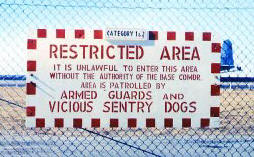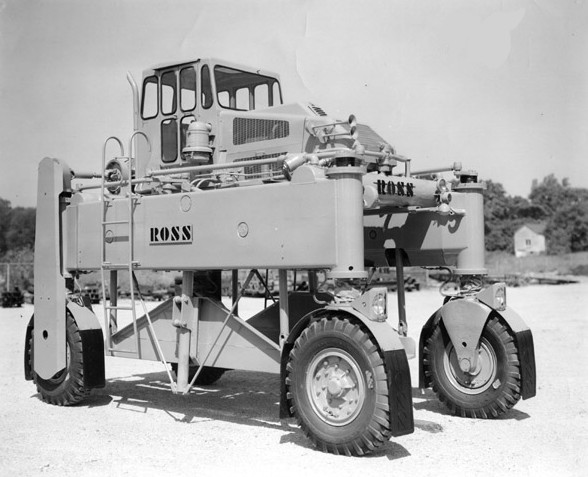Stony Brook AFS was the nuclear weapons storage and maintenance facility for Westover alert aircraft. Within its confines rested a significant number of the world's most lethal thermal nuclear devices. Stony Brook AF Station was where the point of the "Big Stick" of SAC rested under the protection of its own 3084th Air Police Squadron.
At any given time there were, at the height of the "cold War," either 10 or 15 B52s of the 99th Bomb Wing on alert at Westover. These aircraft were uploaded and "hot," ready to be airborne within minutes of an alert being sounded. So, how did these ultimate weapons of last resort get between their ultra-safe storage facility to the flight line and back? The answer is through significant cooperation between the Air Police of Stony Brook, the 3084th APS, and the 814th CDS of Westover.
The premier website regarding the operations of Stony Brook has been accurately researched, assembled and is maintained by Clarke Ketter who served at Stony Brook AFS from 1956 to 1959. His website,
3084th Aviation Depot Group
Stony Brook Air Force Station
A History of a Cold War Mission
can be found Here
It leaves no doubt regarding Stony Brook's strategic contribution in insuring the fulfillment of SAC's mission at Westover.
When a B52 came out of maintenance and was scheduled for alert status, it was towed to hard stand #10 where it would be accepted by the crew chief and ground crew. More times than not, it was also at hard stand #10 where the B52 would receive its nuclear payload. The defining methodology of transfer between Stony Brook and the Westover flight line was set forth in the
Joint Agreement between WAFB and SBAFS Part II Special Weapons Operational Procedures. Through the efforts of Clarke Ketter this document has recently been declassified under the freedom of information act and is presented
here in PDF format for your examination.
The word usually came down at Guard Mount on the 8:00AM to 4:00PM shift that assigned members of the Strike Teams, for that given day, would have convoy duty escorting nuclear units from Stony Brook AFS to the upload area on the Westover ramp. It wasn't bad duty it's just that it took forever and there were the transfer protocols that were often tense between the AP's of the 3084th SBAFS and the 814th CDS of Westover. Stony Brook was it's own fortified secured area within the confines of Westover, something akin to a secure area within a secure area inside a third secured area. There was an outer permitter fence surrounding all of Westover. Inside that, there were several distinct and separate security zones; one containing the fight line and active runways, several zones for varying type of alert aircraft and then there was Stony Brook. Access to these zones was determined by your need to be there and this "need" was visually discernible by an ID badge (a line badge) worn on the outside garment of what ever clothing you were wearing at the time. The line badge was usually green and white in color with your photo, name, rank, SN, Identification of your organization and most importantly what areas you were allowed in. The 814th was not allowed entrance to Stony Brook for a very simple reason, we had no business there, it wasn't our duty station. So when it came time to escort the nuclear weapons from the "Q" gate of SBAFS, onto the flight line of Westover, the hand off of responsibility could take some patience .
The first time you were assigned to one of these convoys could be a daunting experience. Along with being issued the standard fully automatic or semi automatic M2 Carbine(rate of fire was determined by a selector lever on the left hand side of the weapon), each member of the team was also issued a side arm. Usually the 1911-A 45 caliber semi automatic. Extra rounds of ammunition for both weapons were also issued, 60 extra rounds for the M2 (90 rounds in total) and 12 extra rounds for the 45 (18 rounds in total). In addition, the team was reminded that use of "Deadly Force", should the need arise in protecting the nuclear weapons, was authorized. This was not an unusual authorization for the 814th as those who manned the Flight Line and Line Gate posts did have, as a standing order, the sanctioned use of deadly force.

When members of the 814th Strike Teams were tasked to ride shotgun on the Straddle Carriers the Teams would drive up to a major check point at Stony Brook and were directed not to approach any closer than a specified distance. The Straddle Carriers would then come through a double fenced 10 foot high gate. On the inside of Stony Brook the Straddle carriers went through one gate. once past that gate it would close behind them and the second gate would open and the straddle carrier would go through the second gate. That gate would then close and the carrier would then stop. It was at this point that the 814th NCOIC would approach either a NCOIC or an Officer from Stony Brook, it varied, and exchange the escort orders. Only when this was accomplished and the Stony Brook AP dismounted the Straddle Carrier was the 814th CDS Strike Team member then permitted to climb the ladder on the starboard side of the Straddle Carrier and sit up next to the driver. The SAC policy of always two people being present when accompanying nuclear weapons was never broken.

Straddle Carrier for the MK-17 Nuclear Weapon
The trip from the seclusion of Stony Brook to the cacophony of sound and activity of the Westover flight line often had its moments of concern. However, to date, I have found no record of shots being fired.
Sgt. Bill Allen of the 814th CDS was stationed at Stony Brook on the "Q" gate in the late '60s. He reports that upon occasion when a convoy left Stony Brook for the Westover flight line there were incidence's where vehicles coming from Westover to Stony Brook would, shall we say, find themselves in a ditch along the side of the road. Prior to the departure of a convoy from Stony Brook a series of very obvious yellow signs with flashing alert lights would be activated. The signs very clearly stated that single lane road was closed to all traffic. If the convoy met oncoming traffic the convoy did not stop. On more than one occasion oncoming vehicles found themselves with the option of being run over or run off the road. I believe Sgt. Allen noted that the drivers of on coming vehicles opted to see if they could fit into the ditch. There to stay under the watchful eyes of a Strike team untill the convoy passed.




